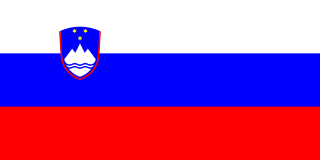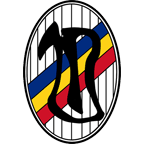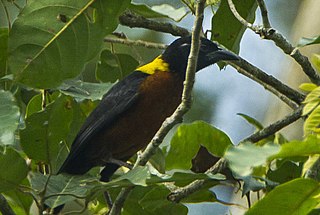
The national flag of Romania is a tricolor with vertical stripes, beginning from the flagpole: blue, yellow and red. It has a width-length ratio of 2:3.

The national flag of Slovenia features three equal horizontal bands of white (top), blue, and red, with the Slovene coat of arms located in the upper hoist side of the flag centered in the white and blue bands. The coat of arms is a shield with the image of Mount Triglav, Slovenia's highest peak, in white against a blue background at the center; beneath it are two wavy blue lines representing the Adriatic Sea and local rivers, and above it are three six-pointed golden stars arranged in an inverted triangle which are taken from the coat of arms of the Counts of Celje, the great Slovene dynastic house of the late 14th and early 15th centuries.
Tricolor or tricolour, or tricolored, tricoloured, may refer to:

Megachilidae is a cosmopolitan family of mostly solitary bees whose pollen-carrying structure is restricted to the ventral surface of the abdomen. Megachilid genera are most commonly known as mason bees and leafcutter bees, reflecting the materials from which they build their nest cells ; a few collect plant or animal hairs and fibers, and are called carder bees, while others use plant resins in nest construction and are correspondingly called resin bees. All species feed on nectar and pollen, but a few are kleptoparasites, feeding on pollen collected by other megachilid bees. Parasitic species do not possess scopae. The motion of Megachilidae in the reproductive structures of flowers is energetic and swimming-like; this agitation releases large amounts of pollen.

The national flag of Afghanistan consists of a vertical tricolor with the classical National Emblem in the center. The current flag was adopted on August 19, 2013, but many similar designs had been in use throughout most of the 20th century.

The tricolored heron, formerly known as the Louisiana heron, is a small species of heron native to coastal parts of the Americas; in the Atlantic region, it ranges from the northeastern United States, south along the coast, through the Gulf of Mexico and the Caribbean, to northern South America as far south as Brazil. In the Pacific region, it ranges from Peru to California, but it is only a nonbreeding visitor to the far north.

Wild pansy, also known as Johnny Jump up, heartsease, heart's ease, heart's delight, tickle-my-fancy, Jack-jump-up-and-kiss-me, come-and-cuddle-me, three faces in a hood, or love-in-idleness, is a common European wild flower, growing as an annual or short-lived perennial.

The tricolored bat is a species of microbat native to eastern North America. Formerly known as the eastern pipistrelle, based on the errant belief that it was closely related to European Pipistrellus species, the closest known relative of the tricolored bat is now recognized as the canyon bat. Its common name "tricolored bat" derives from the coloration of the hairs on its back, which have three distinct color bands. It is the smallest bat species in the eastern and midwestern US, with individuals weighing only 4.6–7.9 g (0.16–0.28 oz). This species mates in the fall before hibernation, though due to sperm storage, females do not become pregnant until the spring. Young are born helpless, though rapidly develop, flying and foraging for themselves by four weeks old. It has a relatively long lifespan, and can live nearly fifteen years.

Unirea Tricolor Bucureşti was a Romanian football club from Bucharest, south-east Romania, founded in 1926 when two clubs, Unirea Bucureşti and Tricolor Bucureşti merged.

Sampaio Corrêa Futebol Clube, usually known as Sampaio Corrêa, is a Brazilian association football club from São Luís, Maranhão state, founded on March 25, 1923.

The genus Megachile is a cosmopolitan group of solitary bees, often called leafcutter bees or leafcutting bees; it also includes the called resin bees and mortar bees. While other genera within the family Megachilidae may chew leaves or petals into fragments to build their nests, certain species within Megachile neatly cut pieces of leaves or petals, hence their common name. This is one of the largest genera of bees, with more than 1500 species in over 50 subgenera. The introduced alfalfa leafcutter bee is managed for crop pollination in various regions around the world.

In the mathematical field of knot theory, the tricolorability of a knot is the ability of a knot to be colored with three colors subject to certain rules. Tricolorability is an isotopy invariant, and hence can be used to distinguish between two different (non-isotopic) knots. In particular, since the unknot is not tricolorable, any tricolorable knot is necessarily nontrivial.
The hybrid elm cultivar Ulmus × hollandica 'Tricolor' was first listed as U. suberosa tricolor by C. de Vos in 1867.

The yellow-mantled weaver is a species of bird in the family Ploceidae. It is sparsely distributed across the African tropical rainforest.
Inocybe tricolor is a rare member of the genus Inocybe that is widely distributed in temperate forests. It is a small mycorrhizal mushroom that contains the hallucinogens psilocybin and psilocin. Inocybe tricolor is found under Norway spruce in central Europe.

Tricolor TV is the Russia's largest direct-to-home provider based in Saint-Petersburg and has broadcast two hundred TV channels in the European part of Russia and Siberia since 2005. As of October 2014, Tricolor TV provided satellite services to over fifteen million subscribers.

The cockade of Italy is the national ornament of Italy, obtained by folding a green, white and red ribbon into a plissé using the technique called "plissage" (pleating). It is one of the national symbols of Italy and is composed of the three colors of the Italian flag with the green in the center, the white immediately outside and the red on the edge: this convention on the position of colors derives from the cockades used in Bologna in 1794 during an attempt of revolt, which had this chromatic composition. The cockade with the red and green inverted position is instead that of Iran.

The cockade of France is the national ornament of France, obtained by circularly pleating a blue, white and red ribbon. It is composed of the three colors of the French flag with blue in the center, white immediately outside and red on the edge.














